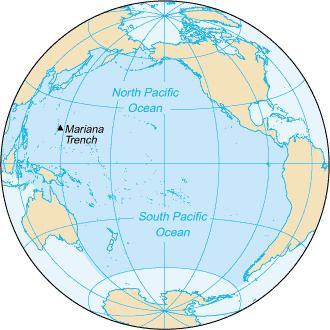 | ||
The Eltanin impact was an asteroid impact in the eastern part of the South Pacific Ocean during the late Pliocene 2.51 ± 0.07 million years ago. The location was at the edge of the Bellingshausen Sea 1,500 km (930 mi) southwest of Chile. The asteroid was estimated to be about 1–4 km in diameter and the impact would have left a crater approximately 35 km across.
Contents
The impact was first discovered in 1981 as an iridium anomaly in sediment cores collected by the research vessel Eltanin, after which the impact and asteroid are named. Later studies were done by the vessel Polarstern. Sediment at the bottom of the 5 km (3.1 mi) deep ocean in the area had an iridium enrichment, a strong sign of extraterrestrial contamination. Debris from the asteroid is spread over an area of 500 km2 (190 sq mi). Sediments from the Eocene and Paleocene were mixed up and deposited again chaotically. Also mixed in were melted and fragmented meteorite matter. The area near the Freeden Seamounts over 20,000 km2 (7,700 sq mi) has a meteorite material surface density of 10–60 kg/m2. Of this, 87% is melted and 13% only fragmented. This is the region of the Earth's surface with the highest density of meteorite material coverage.
The disturbed sediment had three layers. The bottommost layer SU IV is a chaotic mixture of broken up sediments in the form of a breccia. Above this is layer SU III consisting of layered sand deposited from turbulently flowing water. Above this is SU II layer with meteorite fragments and graded silt and clay that settled out of still but dirty water.
Asteroid
The impacting body, the Eltanin asteroid was between 1 and 4 km (0.6 and 2.5 mi) in diameter and traveled with a speed of 20 km/s (12 mi/s). The size of the asteroid can be calculated by the amount of iridium found in the disturbed sediments. Assuming that there were 187 parts per billion of iridium in the asteroid, the known distribution of the metal leads to estimates that the body was over 1 km (0.6 mi) in size. Based on a diameter of 1 km, it is estimated it would have left a crater about 35 km across.
The composition of the meteorites classifies them as low metal mesosiderites. The meteorite explosion also produced microspherules under half a millimeter in diameter. Some of these are glass, and others have spinel and pyroxene. Elements enriched include calcium, aluminium and titanium.
Tsunami
On the shorelines of the Pacific Ocean there are erosional features that are indicative of a very large tsunami. These include an erosional surface and chaotic deposits of mixed terrestrial and ocean-derived sediment. Boulders as big as buses are mixed with marine fossils and mud. The most well-characterised tsunami deposits are near the coast of Chile. Off the coast of Antarctica there are mudslides into the deep ocean from this age.
The size of a possible tsunami has been calculated. An asteroid that was 4 km (2.5 mi) in diameter falling onto the 5 km (3.1 mi) deep ocean would have blasted the water off the ocean floor for at least 60 km (37 mi), and made a wave over 200 m (660 ft) high on the southern end of Chile and the Antarctic Peninsula. After ten hours, waves around 35 m (115 ft) would reach Tasmania, Fiji and Central America, and the New Zealand east coast would have been washed with 60 m (200 ft) high waves. If the impact object was 1 km (0.6 mi) in diameter, the wave heights would be five times less.
Ice age trigger
At the time of the impact, namely the late Pliocene, the earth was cooling, but the impact and disruption to the weather could well have triggered the start of ice cap formation in the Northern Hemisphere. The impact would have put a large amount of water and salt into the atmosphere, disrupted ice shelves, depleted the ozone layer, caused surface acidification, and increased the Earth's albedo. However, the impact had no discernible direct effect on the Earth's biosphere.
